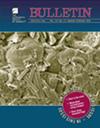美国蒙大拿州中西部小带山脉晚白垩世的发掘与赫勒拿隆起的区域发育
IF 3.9
1区 地球科学
Q1 GEOSCIENCES, MULTIDISCIPLINARY
引用次数: 0
摘要
相对于塞维尔褶皱冲断带的其他部分,蒙大拿中西部的海伦娜凸起及其附近的变形时间约束较差。本研究提供了来自小带山脉的低温热年代学数据,小带山脉是一个基底核的Laramide隆起,与凸起的前缘并列。对8个古元古代基底样品进行了磷灰石裂变径迹(AFT)和锆石(U-Th)/He (ZHe)热年代学分析。4个样品的AFT年龄从80 Ma到73 Ma不等,并伴有较长的单峰封闭径迹,表明晚白垩世小带山基底的快速冷却和挖掘。另外4个样品的AFT年龄较年轻(约55 Ma),表明其在磷灰石部分退火带中停留时间较长,且在挖掘后岩浆再加热。总共有20个新的哲年代,范围从约236 Ma到28 Ma,并显示了日期与有效铀之间的相关性。浙资料的正演模型结果与元古代地壳上层居住,显生宙埋藏和晚白垩世快速冷却相一致。小带山脉的横断面显示了火山谷断裂带的几何形状,火山谷断裂带是一系列南下元古代正断层,对科迪勒拉冲断带的发育产生了深远的影响。我们从小带山脉得到的新约束与从赫勒拿岛凸起得到的已公布的运动学约束相结合,揭示了冲断带的这一部分在约80 Ma至55 Ma之间发生了显著的乱序变形。提出了一个运动学模型,该模型涉及晚白垩世(约80 Ma)在海伦娜湾带超群底部的流变不完备单元的开采,促进了小带山脉的早期发掘。我们的新资料和综合结果与先前的解释一致,即在白垩纪-始新世早期,继承的元古代地层和构造结构是赫勒拿隆起发育的主要控制因素。本文章由计算机程序翻译,如有差异,请以英文原文为准。
Late Cretaceous exhumation of the Little Belt Mountains and regional development of the Helena salient, west-central Montana, USA
The timing of deformation within and adjacent to the Helena salient of west-central Montana is poorly constrained relative to other segments of the Sevier fold-and-thrust belt. This study presents low-temperature thermochronology data from the Little Belt Mountains, a basement-cored Laramide uplift that is juxtaposed with the leading edge of the salient. We analyzed eight samples of Paleoproterozoic basement for apatite fission-track (AFT) and zircon (U-Th)/He (ZHe) thermochronology. Four samples yielded AFT ages ranging from ca. 80 Ma to 73 Ma and associated long, unimodal confined track lengths, indicating rapid cooling and exhumation of Little Belt Mountains basement during the Late Cretaceous. The other four samples are characterized by younger AFT ages (ca. 55 Ma), which suggest a combination of prolonged residence in the apatite partial annealing zone and postexhumation magmatic reheating. In total, 20 new ZHe dates range from ca. 236 Ma to 28 Ma and show a correlation between date and effective uranium. Forward model results for ZHe data are consistent with upper-crustal residence during the Proterozoic followed by Phanerozoic burial and rapid Late Cretaceous cooling. Cross sections across the Little Belt Mountains display the geometry of the Volcano Valley fault zone, an array of down-to-the-south Proterozoic normal faults that profoundly influenced the development of the Cordilleran thrust belt. Our new constraints from the Little Belt Mountains when integrated with published kinematic constraints from the Helena salient reveal significant out-of-sequence deformation in this portion of the thrust belt between ca. 80 Ma and 55 Ma. A kinematic model is proposed that involves Late Cretaceous (ca. 80 Ma) exploitation of rheologically incompetent units at the base of the Belt Supergroup within the Helena Embayment, facilitating early exhumation in the Little Belt Mountains. Our new data and synthesis are consistent with previous interpretations in which an inherited stratigraphic and structural architecture of Proterozoic ancestry was the predominant control on the development of the Helena salient during Cretaceous−early Eocene time.
求助全文
通过发布文献求助,成功后即可免费获取论文全文。
去求助
来源期刊

Geological Society of America Bulletin
地学-地球科学综合
CiteScore
9.30
自引率
8.20%
发文量
159
审稿时长
4-8 weeks
期刊介绍:
The GSA Bulletin is the Society''s premier scholarly journal, published continuously since 1890. Its first editor was William John (WJ) McGee, who was responsible for establishing much of its original style and format. Fully refereed, each bimonthly issue includes 16-20 papers focusing on the most definitive, timely, and classic-style research in all earth-science disciplines. The Bulletin welcomes most contributions that are data-rich, mature studies of broad interest (i.e., of interest to more than one sub-discipline of earth science) and of lasting, archival quality. These include (but are not limited to) studies related to tectonics, structural geology, geochemistry, geophysics, hydrogeology, marine geology, paleoclimatology, planetary geology, quaternary geology/geomorphology, sedimentary geology, stratigraphy, and volcanology. The journal is committed to further developing both the scope of its content and its international profile so that it publishes the most current earth science research that will be of wide interest to geoscientists.
 求助内容:
求助内容: 应助结果提醒方式:
应助结果提醒方式:


